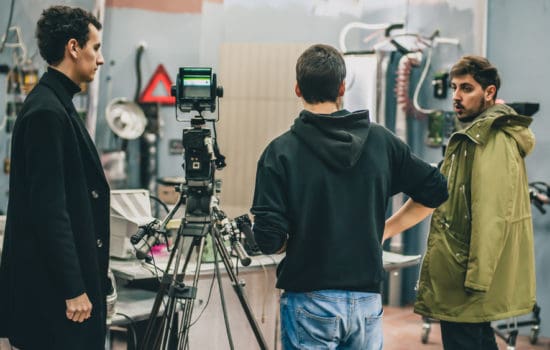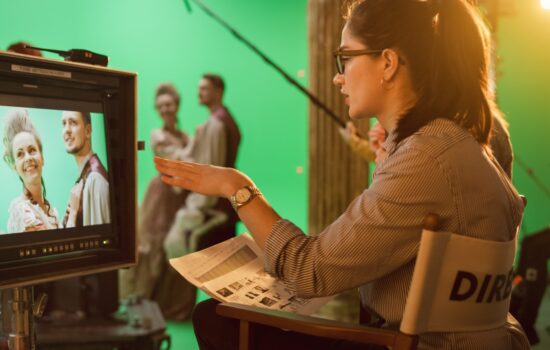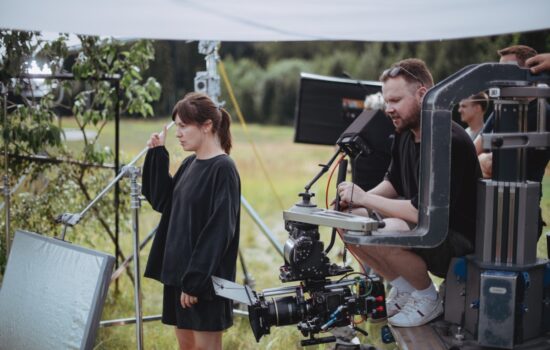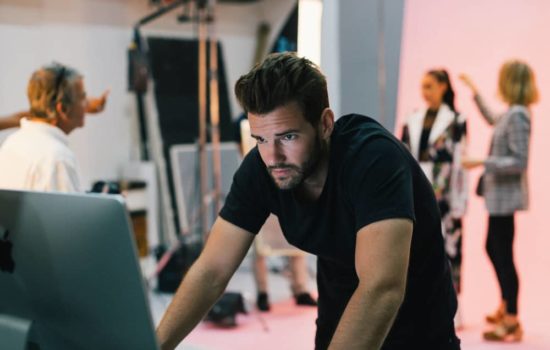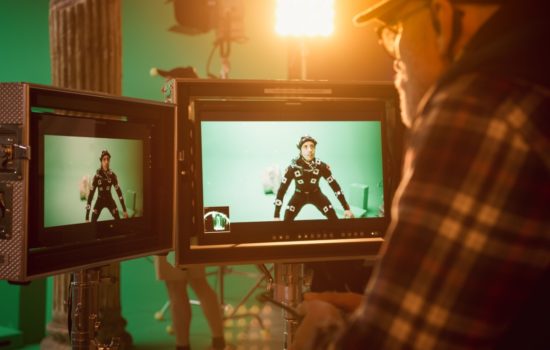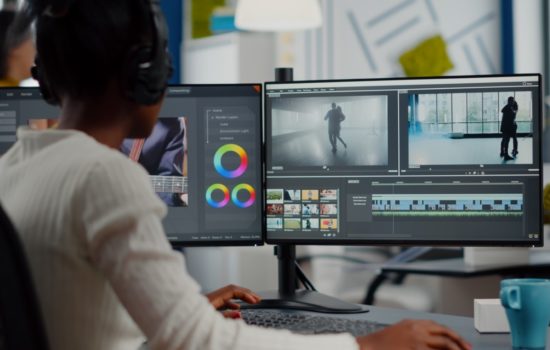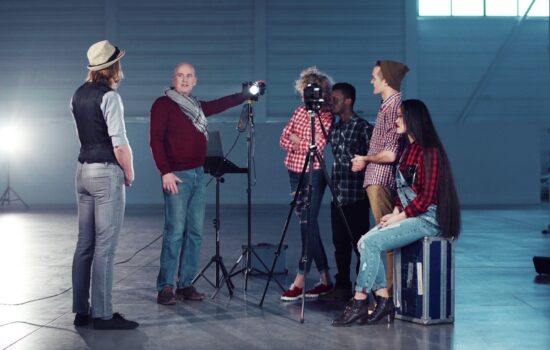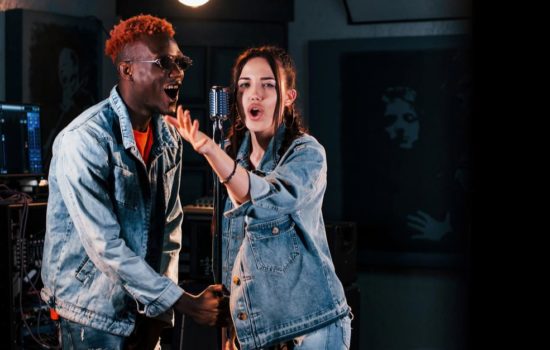Art Director

How To Become an Art Director
People also ask
Career Description
Yana Rusanova, experienced freelance Art Director and Production Designer, explains that an Art Director’s role is extremely varied and her focus shifts depending on the budget of the project.
She explains, “On the big-budget television shows and features, the Art Director is responsible for all construction and signage, executing the Production Designer’s vision. This includes building sets for the shoot and creating any visual signage that is needed.”
Where budgets allow, the teams are extensive: “Art Directors work in tight collaboration with the Production Designer, any Graphic Designers, Set Designers, Set Dressers and Construction Coordinators. We even have Assistants and an Art PA to assist with routine tasks such as research, location scouting and distributing materials to the crew.”
Rusanova sets out the differences between big-budget and lower budget projects: “With less money available, most often the Art Director and Production Designer positions are merged — we have fewer people in the Art Department so one person takes on multiple roles.” She clarifies that on ultra-low budget and commercial/music video shoots, departments become even less differentiated: “The Art Director essentially becomes the art and set decoration departments.”
What does an Art Director do?
The Art Director on a film must ensure that the visual artistic elements are in sync with each other and in service of the story being told. That means maintaining the cohesiveness of the costumes, makeup, hair, and production design. To that end, the Art Director is in constant communication with the Production Designer, Key Hair and Makeup Artists, and Costume Designer.
Salary
The average annual salary for an Art Director is approximately $74,300. The salary range for Art Directors runs from $50,000 to $112,000.
Art Directors and Production Designers, like most filmmakers, are freelancers. Rusanova clarifies that, at the non-union end of your career, you negotiate your rate. “If you are interviewed for an Art Director position, and the offered rate is too low, you can always negotiate with production by adding computer fees, gas mileage or asking for a higher rate.”
Given the per production nature of pay, rates vary widely depending on budget and experience. Rusanova lays it out: “If you’re starting out on a student film, you can expect around $200 per day. Music videos pay around $300-400 per day, whereas commercials pay entry-level positions $350 per day.”
In terms of features and television shows, again, rates fluctuate: “Often productions will ask you for your rate so it is important for you to establish what your baseline is before negotiating. A respected daily rate for an Art Director on a low-budget feature is around $550. Productions will then build team members’ pay using the department head’s rate as the highest reference.”
Union jobs have fairly fixed rates according to the rates cards established by local unions. On a union television show, Art Directors can expect to earn between $2,500 and $3,500 per week.
Do Art Directors make good money?
They certainly can under the right circumstances. A veteran Art Director with union status and great industry connections who works regularly on projects can earn nearly $150,000 in a single year. On average, though, that number is closer to $100,000. That being said, for someone just starting out as an Art Director, they may make considerably less as they build their resume with indie projects that tend to have smaller budgets.
Hey, what do you think about trying our new Film Career HelperFilm Career Helper really quick? It’s totally free and could help get your career moving fast! Give it a try. It’s totally free and you have nothing to lose.
Career Outlook
Unbending love for the film industry is the only way to make this career work, says Rusanova. “When you start out as an Art PA, a Set Decorator PA or On-Set Dresser, be prepared to work 12-14 hour days, work overnights/weekends and work outside for long stretches.”
She explains that once you are art directing on bigger-budget productions, it becomes easier to manage your own schedule, but the path there involves physically demanding work: “Shoots involve long days of standing very quietly on set or doing laundry or running errands. Above all, intense concentration is the greatest demand, ensuring you’re always on top of on-set challenges. That never changes.”
Rusanova emphasizes the need to enjoy the work: “If you like the work, it’s fun. Simple as that.” She admits it is a challenge keeping up with friends and family, and explains, “For periods of time, your coworkers become your friends and family, especially on distant locations.”
She recommends taking rest when possible, adding that, “Freelancing is tough — there’s always the fear of unemployment until you build up your network. Don’t worry, you will get there. You must allow yourself to rest as it will give you perspective and nourish new ideas.”
Career Path
For anyone eyeing Art Department work, Rusanova has a number of practical suggestions: “I spent my first year building my experience as an Art PA on student films. On these ultra-low budget shoots, you take on responsibilities and jobs well above your pay grade — it’s a rich sandbox for learning.”
Rusanova then moved on to independent features, commercials, and music videos, soon understanding that union membership was her next, crucial step: “Low budget union shows are more inclined to hire non-union people, so find an entry-level position in the Art Department that will allow you to build up enough hours to join your Local 44 union. I started as a Set Dresser, others were starting as Shoppers, and we moved up the Art Department ladder.”
Rusanova lays out a clear path to become an Art Director or Production Designer: “You can start as a Graphic Designer or Art PA, then look to become an Assistant Art Director. Another route is to start with set dressing or shopping, then move along to set decorating before stepping into the leadership roles of Art Director or Production Designer.”
Rusanova is also quick to remind that, “On the way up, you might find you love your current position and decide not to move on!”
There are certain majors that can be helpful for transitioning into an Art Director role, advises Rusanova. Interior Design, Architecture and Graphic Design majors all incorporate applicable skill sets. But what about finding those all-important first gigs?
“Two interesting places are the Facebook Art Department community and the Gigs section on Craigslist — people often post jobs on these online forums. I got my first AFI student films on mandy.com, but I do remember it was free to join back then!” Above all, any experience in the Art Department will serve you well once you graduate to an Art Director role.
Says Rusanova, “That way, once you head the department, you will have an authentic understanding of everyone’s role.”
- Set your goal early on. If you know where you want to end up, you can work towards it in a more focused way.
- Work hard. The entertainment industry roots out anyone “phoning it in.” If you work hard, people will want you back.
- The most golden rule: be nice.
Is Art Director a hard job?
In short, yes. But that doesn’t mean you can’t achieve this position with enough time, dedication, and hard work. Every specialty in filmmaking has many more people wanting to do it than there are jobs for it.
With such high competition, it’s important that an aspiring Art Director do all that they can to gain experience, connections, and other skillsets to make them the most desirable candidate for a job.
Once a person has achieved the role of Art Director on a project, the work doesn’t stop. Rather, they must always be hustling not only to ensure the success of their current production but also to increase the odds of them securing the next one.
Experience & Skills
Rusanova reiterates that there are countless online resources for any Art Department passion. “You can learn to sketch, which is vital to any aspiring Art Director, or you can build your knowledge of interior design, architecture and even color theory — really, all aesthetic pursuits are important for building your own taste and profile.”
In terms of the everyday work, Rusanova is clear about how to succeed and forge your way to an Art Director role: “It is important to be easygoing and positive – nobody likes to work with grumpy people!”
Above all, she emphasizes that work ethic is key: “Don’t talk instead of working. Don’t stand in the middle of a set looking lost. Ask questions, smile, and look to help out once you’ve finished your own tasks. That kind of attitude will ensure people want to work with you again and again.”
Art Directors and Production Designers are leadership roles, and Rusanova says that her attitude sets the tone for her team members. “You need to learn to negotiate and keep everyone content. This means staying open-minded and not being ‘married’ to any of your ideas – production is collaborative and fast-moving and any idea can be changed rapidly during prep,” she explains.
She also stresses the need to be realistic: “There are times when Art Directors and Production Designers end up overpromising in their desire to please Producers. Particularly on lower budget productions, labor resources, time and materials are already scarce so big promises can lead to poor-quality, dangerous work.”
Rusanova has a rule; she calls it “the triangle rule.” “There is cheap, there is fast, and there is good. But you can only achieve two at a time. You want cheap and fast? It won’t be good. You want good and cheap? It won’t be fast. And so on.”
Rusanova’s attitude is one of practical realism: “It is best to be clear, sometimes even tough, to make sure everyone knows where they stand and what the expectations are. Art Directors must learn to be confident and transparent in their approach.”
Education & Training
“It is very common to find experienced people in the Art Department who never went to film school,” explains Rusanova, who herself is entirely self-taught. “I have a Diploma in International Relations from my school in Russia, so I taught myself everything.”
Rusanova has plenty of practical wisdom for aspiring Art Directors: “I recommend learning how to use basic design software, including SketchUp, Photoshop, and Illustrator. Some productions also use Celtx or Synconset for inter-departmental coordination so it pays to be familiar with those, too.”
She notes that any Art Department role requires personal inspiration: “Research, explore, follow your taste — I love learning about camera lenses, shot composition and lighting. Storyboarding has also helped me considerably with my artistic vision. There are a lot of resources freely available online.”
Nonetheless, Rusanova highlights some more formal options for consideration. Those eager for training but not looking to pay “crazy money” for film school should check out The Hollywood CPR Program, a non-profit training program for entertainment artists, craftspeople and technicians.
“You can choose which department you train for and, other than real dedication to your craft (no missing classes!), there are no formal requirements for entry. After finishing the program, you can also apply to the union with having to earn days on union shows — that’s a huge plus.”
“For those with more resources on hand, Rusanova suggests the Production Design Program at the AFI Conservatory: “I have worked frequently with their students and graduates and the training is top-notch.”
Additional Resources
For Art Directors (and Production Designers), there are two guilds specific to the crafts, the Local 800 and the Art Directors Guild of America. Eventual membership in either is essential; specific requirements and how to become a member can be found on their website.
Rusanova also has advice for entry-level roles: “Here, we have Local 44 for positions such as Set Decorators, Set Dressers, Property Masters, Shoppers and Drapers. Becoming a member means medical insurance, guaranteed overtime/double-time payment, sick day and disability payments, as well as pensions and life insurance.”
FAQ
What is the single biggest suggestion you would give to someone wanting to get into this career?
“Never work for free, even at the very beginning. If you are helping out a friend, ask them to cover your gas or give you a little money as an equipment fee. You are giving your energy and time — make sure you are compensated for it.”
What’s the #1 mistake people make when trying to get into this career?
“Talking, instead of working. Many people talk about what they are going to do, instead of getting on and doing it.”
What is the question people should ask about this career but rarely do?
“They rarely ask about making the switch from ‘real world’ to the working ‘movie world.’ There’s so little time to do anything outside work so maintaining friends and relationships is a perpetual struggle. And forget about parties!”
If you could describe in one word what makes you successful, what would it be?
“Industrious.”
Sources
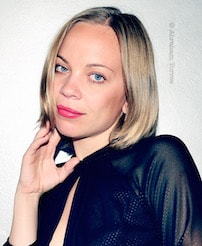
Yana Rusanova
Yana Rusanova was born and raised in Siberia, Russia. She moved to LA in 2010 and, after storyboarding for an independent animation series, she became the Graphic Designer for an AFI student film. This stoked her interest in more hands-on film work and she took an Art PA job, graduating quickly to Set Dresser, then Property Master, and then finally to Art Director and Production Designer.
Her wide experience includes independent, low budget features such as Drone Wars and Savage Dog, pilots including Parole, executive produced by Academy Award-nominee Marianne Jean-Baptiste, and union television shows such as Drug Lords on Netflix.
Outside of work, she loves to travel and read Russian classics. Improv and drums are her stress relief.
Photo credit: Fine Art Photography by Rumbleskout3.
References
- 1Multiple. "Art Director Salaries". Glassdoor. published: Dec 13, 2019. retrieved on: Dec 14, 2019
